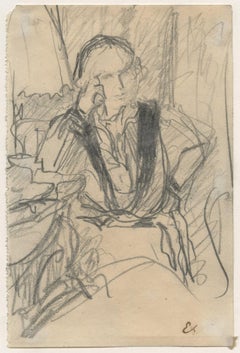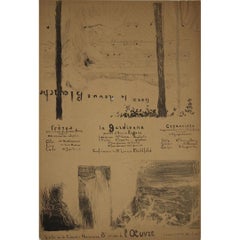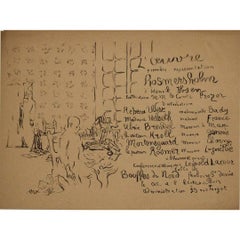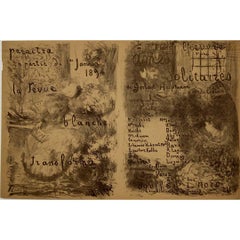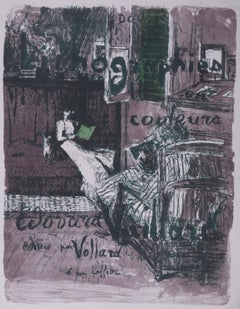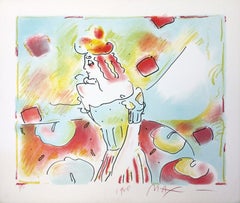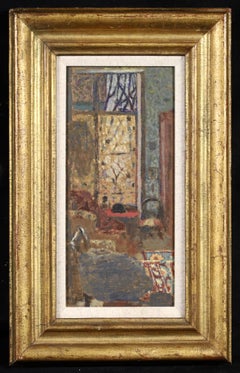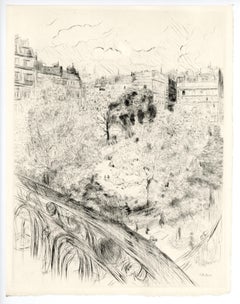Edouard Vuillard Art
French artist Edouard Vuillard was known for depicting intimate glimpses of Parisian life around the turn of the 20th century. His figurative prints, drawings and figurative paintings were concerned not just with their subjects but with the private surroundings of their homes and gardens. Vuillard was strongly influenced by Postimpressionist painters like Paul Gauguin.
Vuillard was born in the French commune of Cuiseaux in 1868. His family moved to Paris in 1877, and six years later, he received a scholarship to study at the prestigious Lycée Fontaine (now called the Lycée Condorcet). He graduated in 1885, joined the studio of painter Diogène Maillart and enrolled in courses at Académie Julian. Two years later, he was also accepted to the École des Beaux-Arts.
In 1889, the young Vuillard began meeting with a group of Symbolist painters and mystics known as Les Nabis (the prophets). For the subsequent decade, he was a prominent member of the group. During this period, Les Nabis and Vuillard himself were influenced by Japanese woodblock prints, featuring a blending of shapes and colors and a shallow depth of field. Any figures in the paintings seemed to meld into the background, and the loose brushwork prefigured the advent of abstract art.
Les Nabis broke up in 1900, and Vuillard's work took on a brighter and more colorful appeal. He turned his attention to painting gardens, joining a rich tradition of French garden painters. Vuillard was nominated for the Légion d'honneur in 1912, but he refused on the grounds that he did not seek compensation for his work other than the esteem of people with good taste.
After a brief stint in the military during World War I, Vuillard returned to life as a painter. In the 1920s, he was commissioned for portrait paintings by prominent Parisians like director Sacha Guitry, the Contesse Marie-Blanche de Polignac and fashion designer Jeanne Lanvin.
Throughout the 1930s, Vuillard received numerous commissions from the French government. In 1938, he had a major retrospective at the Musée des Arts Decoratifs and was elected to the Académie des Beaux Arts. He died in 1940, at the age of 71.
On 1stDibs, find Edouard Vuillard prints, drawings and paintings.
1930s Modern Edouard Vuillard Art
Etching
1910s Impressionist Edouard Vuillard Art
Graphite
1890s Edouard Vuillard Art
Paper, Lithograph
1890s Edouard Vuillard Art
Paper, Lithograph
1890s Edouard Vuillard Art
Paper, Lithograph
1890s Post-Impressionist Edouard Vuillard Art
Lithograph
1890s French School Edouard Vuillard Art
Lithograph
Late 19th Century Edouard Vuillard Art
Lithograph
1910s French School Edouard Vuillard Art
Lithograph
1890s Art Nouveau Edouard Vuillard Art
Lithograph
1890s Edouard Vuillard Art
Lithograph
1980s Pop Art Edouard Vuillard Art
Paper, Lithograph
Mid-20th Century Modern Edouard Vuillard Art
Paper, Lithograph
Mid-20th Century Modern Edouard Vuillard Art
Paper, Lithograph
1940s Art Deco Edouard Vuillard Art
Paper, Glitter, Lithograph
Virginia Fisher(Fred Astaire) Judy Garland and Ann Miller in "Easter Parade", Figurative Litho, 1947
1940s Impressionist Edouard Vuillard Art
Watercolor, Gouache, Graphite
20th Century Realist Edouard Vuillard Art
Paper, Color, Lithograph
1970s Art Nouveau Edouard Vuillard Art
Lithograph, Paper
1890s Post-Impressionist Edouard Vuillard Art
Lithograph
1980s Contemporary Edouard Vuillard Art
Lithograph, Paper
1940s Expressionist Edouard Vuillard Art
Paper, Ink, Lithograph
1970s Fauvist Edouard Vuillard Art
Lithograph
Late 19th Century Impressionist Edouard Vuillard Art
Graphite
1890s Post-Impressionist Edouard Vuillard Art
Oil, Board
1930s Edouard Vuillard Art
Etching
1890s Impressionist Edouard Vuillard Art
Oil, Board
1930s Impressionist Edouard Vuillard Art
Etching
1930s Edouard Vuillard Art
Etching
Early 1900s Impressionist Edouard Vuillard Art
Pastel, Board
Early 1900s Impressionist Edouard Vuillard Art
Canvas, Oil
1930s Edouard Vuillard Art
Etching
1890s Impressionist Edouard Vuillard Art
Lithograph
1930s Modern Edouard Vuillard Art
Etching
1890s Impressionist Edouard Vuillard Art
Lithograph
1890s Edouard Vuillard Art
Lithograph
Edouard Vuillard art for sale on 1stDibs.
Artists Similar to Edouard Vuillard
- 1stDibs ExpertNovember 13, 2024Art that looks 3D is called Op art. The Op art movement emerged in the 1960s, mirroring the counterculture of the time in its embrace of visual trickery, graphic shapes and bright colors. Spreading across Europe and the Americas, the style — short for “optical art” — influenced advertising, fashion and interior design before fading in the early ’70s. Op art remained significant, however, for artists and scientists interested in the nature of perception. And today, it’s seeing a resurgence of interest from collectors and interior designers. Some notable artists who created Op art include Victor Vasarely, Josef Albers, Bridget Riley and Jesús Rafael Soto. Find a diverse assortment of Op art on 1stDibs.
- 1stDibs ExpertJanuary 19, 2025Edouard Manet was famous for his work as a painter during the 19th century. He was one of the first artists of his time to paint modern life and a pivotal figure in the transition from Realism to Impressionism. Born into an upper-class household with strong political connections, the French artist rejected the future originally envisioned for him and became engrossed in the world of painting. His early masterworks, The Luncheon on the Grass and Olympia, both made in 1863, caused great controversy and served as rallying points for the young painters who would establish Impressionism. Today, these are considered watershed paintings that mark the start of modern art. On 1stDibs, shop a selection of Edouard Manet art.

